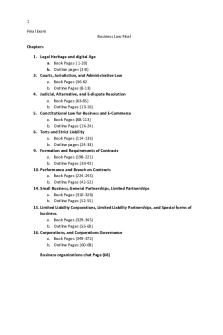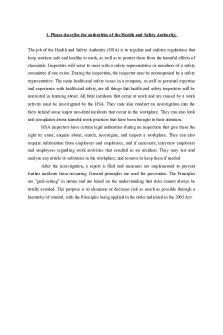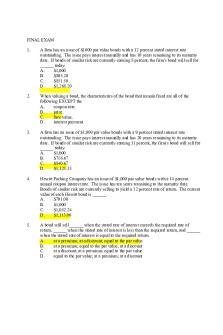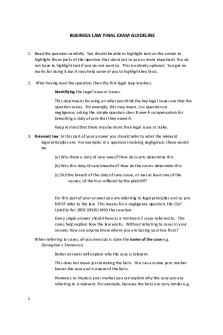Business LAW Final EXAM PDF

| Title | Business LAW Final EXAM |
|---|---|
| Author | Robert Fitzsimmons |
| Course | Business Law |
| Institution | Duquesne University |
| Pages | 70 |
| File Size | 1.2 MB |
| File Type | |
| Total Downloads | 17 |
| Total Views | 177 |
Summary
This is the exam study guide i created from the book. Read and outlined every page of the chapters listed. ...
Description
1 Final Exam Business Law Final Chapters 1. Legal Heritage and digital Age a. Book Pages ( 1-20) b. Outline pages (2-8) 3. Courts, Jurisdiction, and Administrative Law a. Book Pages (36-62 b. Outline Pages (8-13) 4. Judicial, Alternative, and E-dispute Resolution a. Book Pages (63-85) b. Outline Pages (13-16) 5. Constitutional Law for Business and E-Commerce a. Book Pages (88-113) b. Outline Pages (16-24) 6. Torts and Strict Liability a. Book Pages (114-135) b. Outline pages (24-33) 9. Formation and Requirements of Contracts a. Book Pages (198-221) b. Outline Pages (33-42) 10. Performance and Breach on Contracts a. Book Pages (224-245) b. Outline Pages (42-52) 14. Small Business, General Partnerships, Limited Partnerships a. Book Pages (310-326) b. Outline Pages (52-55) 15. Limited Liability Corporations, Limited Liability Partnerships, and Special forms of business. a. Book Pages (329-345) b. Outline Pages (55-60) 16. Corporations, and Corporations Governance a. Book Pages (349-372) b. Outline Pages (60-68) Business organizations chat Page (68)
2 Final Exam Chapter 1: “Legal Heritage and the Digital Age” Pages: (1-20)
LEARNING OBJECTIVES: 1) Define Law. 2) Describe the Functions of Law. 3) Explain the Development of the U.S. Legal System. 4) List and describe the sources of Law in the United States. 5) Discuss the importance of the U.S. Supreme Court’s decision in Brown v. Board of Education. Introduction to Legal Heritage and the Digital Age “Without law we cannot live; only with it can we insure the future which by right is ours. The best of men’s hopes enmeshed in its success” o Every society makes and enforces laws that govern the conduct of the individuals, businesses, and other organizations that functions within it. o Primarily based on (English Common Law, other Legal Systems, such as Spanish and French Civil Law Influence it) Sources of Law in this Country o U.S. Constitution, State Constitutions, Federal and State Statues, Ordinances, Administrative Agency Rules & Regulations, Executive Orders, and Judicial Decisions by Federal and State Courts. Businesses- that are organized in the U.S. are subject to its Laws. Also, subject to the laws of other countries in which they operate. o Businesspeople owe a duty to act ethically in the conduct of their affairs, and businesses owe a responsibility to not harm society. What is Law?
Law- consists of rules that regulate the conduct of individuals, businesses, and other organizations in society (intended to protect persons and their property against unwanted interference from others). In other words, the Law forbids persons from engaging in certain undesirable activities. Definition of Law
Black’s Law Dictionary: o “Law, in its generic sense, is a body of rules of action or conduct prescribed by controlling authority, and having binding legal force. That which must be obeyed and followed by citizens subject to sanctions or legal consequences of law” o Law- that which must be obeyed and followed by citizens, subject to sanctions or legal consequences; a body of action or conduct prescribed by controlling authority and having binding legal force. Functions of Law:
3 Final Exam 1) Keep the Peace Ex: (Some laws make certain activities crimes) 2) Shape Moral Standards Ex: (Some laws discourage drug and alcohol abuse) 3) Promote Social Justice Ex: (Some laws prohibit discrimination in employment) 4) Maintain the Status Quo Ex: (Some laws prevent the forceful overthrow of the government) 5) Facilitate Orderly Change Ex: (Laws are enacted only after considerable study, debate, and public input) 6) Facilitate Planning Ex: (Well-designed commercial laws allow businesses to plan their activities, allocate their productive resources, and assess the risks they take) 7) Provide a Basis for Compromise Ex: (Laws allow or settlement of cases prior to trial. Approximately 95% of all lawsuits are settled in this manner) 8) Maximize Individual Freedom Ex: (The rights of freedom of speech, religion, and association are granted by the First Amendment to the U.S. Constitution)
Schools of Jurisprudential Thought
Philosophy
1) Natural Law
Postulates that law is based on what is “correct”. It emphasizes a moral theory of law that is, law should be based on morality and ethics. Believes that law is an aggregate of social traditions and customs. Maintains that the law is shaped by Logic. Asserts that Law is a means of achieving and advancing certain sociological goals. Believes that the law is a set of rules developed, communicated, and enforced by the ruling party. Maintains that legal rules are unnecessary and that legal disputes should be solved by applying arbitrary rules based on fairness. Believes that promoting market efficiency
2) Historical 3) Analytical 4) Sociological 5) Command
6) Critical Legal Studies
7) Law and Economics
4 Final Exam should be the central concern of legal decision making.
Brown v. Board of Education “We conclude that in the field of public education the doctrine of ‘separate but equal’ has no place.” –Warren, Justice Slavery was abolished by the 13th Amendment to the Constitution in 1865. The 14th Amendment, added to the Constitution in 1868, contains the “Equal Protection Clause”, which provides that no state shall (deny to any person within its jurisdiction the equal protection of the laws). The original premise of this amendment was to guarantee equality to freed African Americans. o But, equality was denied to African Americans for years, including: Discrimination in Housing, transportation, education, jobs, service at restaurants, and other activities. In 1896, the U.S. Supreme Court decided the case of Plessy v. Ferguson. o In that case, the state of Louisiana had a law that provided for separate but equal accommodations for African American and White railway passengers. The Supreme Court held that the “separate but equal” state law did not violate the Equal Protection Clause of the 14th Amendment. The “Separate but Equal Doctrine” was then applied to all areas of life, including: o Public Education, thus, African American and White children attended separate schools, often with unequal facilities. It was not until 1954 that the U.S. Supreme Court decided a case that challenged the “separate but equal” doctrine as it applied to public elementary and high schools. In Brown v. Board of Education, a consolidated case that challenged the separate school systems of 4 states, including: o Kansas, South Carolina, Virginia, and Delaware. The Supreme Court decided to revisit the “separate but equal” o This time, a unanimous Supreme Court, in an opinion written by Chief Justice Earl Warren, reversed the prior precedent and held that the “separate but equal” doctrine violated the Equal Protection Clause of the 14th Amendment to the Constitution. Schools of Jurisprudential Thought
The philosophy or science of law is referred to as jurisprudence. Natural Law School o Postulates that the law is based on what is “correct”. Natural Law philosopher’s emphasize a moral theory of law Law that should be based on morality and ethics. Natural Law is “discovered by humans through the use or reason and choosing between “good and evil”.
5 Final Exam Example: Documents such as the U.S. Constitution, the Magna Carta, and the United Nations Charter reflect this theory. Historical School o Believes that the law is an aggregate of social traditions and customs that have developed over the centuries. Believes that changes in the norms of society will gradually be reflected in the law. o To these legal philosophers, the law is an evolutionary process. Example: Historical legal scholars look to past legal decisions (precedent) to solve contemporary problems. Analytical School o Maintains that the law is shaped by logic. Analytical philosophers believe that the results are reached by applying principles of logic to specific facts of the case. o The emphasis is on the logic of the result rather than how the result is reached. Example: if the U.S. Constitution would have freed the slaves or granted females the right to vote, it would not have been ratified by the states in 1788. Sociological School o Asserts that the law is a means of achieving and advancing certain sociological goals. o The followers of this philosophy are known as Realists (believe that the purpose of the law is shape social behavior). o Sociological philosophers are unlikely to adhere to past law as precedent. Examples: Laws that make discrimination in employment illegal and laws that impose penalties from drunk driving reflect this theory.
Command School o Believe that the Law is a set of rules developed, communicated, and enforced by the ruling party rather than a reflection of the society’s (morality, history, logic, or sociology). o This school maintains that the law changes when ruling class changes. Example: During certain military conflicts, such as WWII and the Vietnam War The Federal Government has enacted draft laws that require men of a certain age to serve in the military if they meet certain physical/other requirements. Critical Legal Studies School o Proposes that legal rules are unnecessary and are used as an obstacle by the powerful to maintain the status quo. o Critical Legal Theorists argue that legal disputes should be solved by applying arbitrary rules that are based on broad notions of what is “fair” in each circumstance. o Under this theory, subjective decision making by judges would be permitted.
6 Final Exam Example: postulates that rape laws make it difficult for women to prove legally that they have been raped because these laws have mostly been drafted from a male’s perspective. Therefore, these laws should be ignored and the judge should be free to decide whether the rape has occurred in (his or her) subjective decision making. Law and Economics School o Believes that promoting market efficiency should be the central goal of legal decision making. This school is also called the Chicago School, named after the University of Chicago, where it was first developed. Example: proponents of the “law and economics theory” suggest that the Federal Government’s policy of subsidizing housing by a law that permits a portion of interest paid on mortgage loans to be deducted from an individual borrower’s federal income taxes and laws that created government-sponsored enterprises (Fannie Mae and Freddie Mac) that purchase low-rate mortgages made by banks and other lending institutions provide incentives so that too many homes are built. If these laws did not exist, then the free market would determine the exact number of homes that should be built. English Common Law
Developed by judges who issued their opinions when deciding cases. Principles announced in these cases became precedent for later judges deciding similar cases. English Common Law can be divided into cases decided by the (Law Courts, Equity Courts, and Merchant Courts) o Law Courts A court that developed and administered a uniform set of laws decreed by the kings and queens after William the Conqueror; Legal procedure was emphasized over merits at this time o Chancery (Equity) Courtsi Because of some unfair results and limited remedies available in Law courts, a (2nd Set of Courts) Court of Chancery or Equity Courts o Under authority of Lord Chancellor, if people believed a decision of the law was unfair, could seek relief in the Court of Chancery. o Rather than emphasize legal procedure, this court inquired into the merits of the case. The remedies were called equitable remedies because they were shaped to (fit each situation). o Equitable orders & remedies of the Court of Chancery (took precedence over legal decisions and remedies of Law Courts) o Merchant Courts
7 Final Exam
A court in England that solved commercial disputes by applying trade practices and usage.
Constitutions Constitution of the United States of America- is the supreme law of the land. o Whether federal, state, or local that conflicts is unconstitutional. o Established as a “living document” to structure the federal government o Legislative Branch (Congress): has the power to make (enact) the law. o Executive Branch: has the power to enforce the law. o Judicial Branch: has the power to interpret and determine the validity of the law. Treaties
US Constitution provides that the president with advice/consent with two-thirds of the senate may enter treaties with foreign governments. Treaties become part of the supreme law of the land. Federal Statues
Statues- are written laws that establish certain courses of conduct that covered parties must adhere to. Congress is empowered by the commerce clause to enact federal statues (organized by topic into code books) to regulate foreign and interstate commerce. State Statues
State legislatures enact state statues such statues are placed in code books. Ordinances State legislatures often delegate lawmaking authority to local government bodies, including (cities, municipalities, counties, school districts, and water districts) Executive Orders
Executive Branch of Government (President, State Governors) are empowered to executive orders. Derived from express delegation from the legislative branch and is implied from the U.S. constitution and state constitutions. Regulations and Orders of Administrative Agencies
Legislative and Executive Branches of federal and state governments are empowered to establish administrative agencies, to enforce and interpret statues enacted by Congress/state legislatures. (these are rules/regulations that have the force of the law) Administrative Agencies usually have the power to hear and decide disputes. Their decisions are called orders. Because of their power Administrative agencies are often formally referred to as “4th branch of government” Judicial Decisions- in these written opinions, a judge/decision explains the legal reasoning used to decide a case.
8 Final Exam Opinions include interpretations of statues, ordinances, and administrative regulations. Doctrine of Stare Decisis: Based on common law tradition, past court decisions become precedent for deciding future cases. o Lower courts must follow precedent established by higher courts. o This is why (federal/state courts must follow precedents established by US Supreme court) o Example- State courts of one state are NOT required to follow the legal precedent established by the courts of another case. Stare Decisis- adherence to the precedent (“to stand by the decision”) o Promotes uniformity of a law within a jurisdiction, makes the court system more efficient & (makes the law more predictable for individuals and businesses) [A court may later change or reverse its legal reasoning if a new case is presented to it and change is warranted] Critical Legal thinking
a method of thinking that consists of investigating, analyzing, evaluating, and interpreting information to solve a legal issue or case. Socratic Method
A process that consists of a series of questions and answers and a give-and-take inquiry and debate between a professor and students. IRAC Method
A method used to examine a law case. IRAC is an acronym that stands for issue, rule, application, and conclusion.
Chapter 3: “Courts, Jurisdiction, and Administrative Law” Pages: (36-62) -
-
Two major court systems in the United states 1. The federal court system 2. The court system of the 50 states; Washington DC; and territories of the US o Federal and state government have created administrative agencies to assist in implementing and enforcing laws State Court System o Every state and territory of the US has its own separate court system Limited jurisdiction trial courts – a court the hears matters of a specialized or limited nature. The decision by this court can be appealed to a general jurisdiction court. EX -Traffic court, juvenile court, justice of the peace courts, family court.
9 Final Exam General jurisdiction trial courts (Court of record) – a court that hears cases of general nature that is not within the jurisdiction of limited jurisdiction trial courts. Testimony and evidence at trial are recorded and stored for future reference. This court hears felonies or civil cases involving more than a certain dollar amount. EX – “New York Supreme Court”, California Superior Court Intermediate appellate courts (Appellate court or court of appeals) – A court that hears appeals from trial courts. They review the trial court record to determine whether there have been any errors at trial that would require reversal or modification of the trial court’s decision. (No new evidence or testimony is permitted!!) Highest state court – the highest court in a state court system; it hears appeals from intermediate appellate state courts and certain trial courts. The decision made by these courts are final unless a question of law is involved then it will go to the US Supreme Court. (Again no new evidence is allow to be submitted) Federal Court System o Article 3 of the US Constitution provides that the federal Government’s judicial power is vested in one “Supreme court” this court is the US Supreme court. o Special Federal Courts – Federal courts that hear matters of specialized or limited
-
jurisdiction.
US Tax court – deals with tax laws US Court of federal claims – hears cases brought against the US US court of international trade – handles cases that involve tariffs and international trade US Bankruptcy court – hears cases that involve federal bankruptcy laws US court of appeals for the armed forces US court of appeals for veteran’s claims Foreign Intelligence Surveillance Court – a court that hears requests from places like the FBI and NSA for warrants called FISA warrants. These are to conduct physical searched and electronic surveillance of Americans or foreigners in the US who are deemed a threat to national security. Almost always get them. o US District courts – the federal court system’s trial court of general jurisdiction. 94 of them. They are empowered to impanel juries, receives evidence, hear testimony, and decide cases.
10 Final Exam
-
-
-
o US Court of Appeals – the federal court system’s intermediate appellate courts. There are 13 circuits in federal court system, the first 12 are geographical, 11 are designated by numbers, as the “first circuit”, “Second Circuit”, and so on. There is normally 2 sometimes 3 judges. The only court that can overturn there decision is the US Supreme Court. o US court of appeals for the federal Circuit – a US court of appeals in Washington Dc that has special appellate jurisdiction to review the decisions of the court of federal claims, the patent and trademark office, and the court of international trade. The Supreme Court of the United States – the highest court in the US, located in Washington DC. The Supreme court was created by Article 3 of the US Constitution. o Composed of 9 justices who are nominated by the president and confirmed by the senate. The president appoints one justice as chief justice. o The justices get appointed by article 2 section 2 of the Constitution. This gives the president the power to appoint the justices with the advice and consent of the senate. So a majority vote. The jurisdiction of the US Supreme Court – is an appellate court, hears appeals from federal circuit courts, federal district courts, special federal courts, and highest state courts. The Supreme court’s decision is final. It doesn’t go any farther. o Petition for Certiorari – a petition asking the Supreme court the hear a case o Writ of Certiorari – an official notice that the Supreme court will review a case Dec...
Similar Free PDFs

Business LAW Final EXAM
- 70 Pages

Business Law Final Exam Study Guide
- 42 Pages

Taxation LAW Final EXAM
- 8 Pages

Law Final Exam 2021
- 4 Pages

Business Law Exam 2 Notes
- 8 Pages

Final exam thames business math
- 5 Pages

Introduction to Business-Final Exam
- 33 Pages

Business Law and Practice MCQ final
- 24 Pages
Popular Institutions
- Tinajero National High School - Annex
- Politeknik Caltex Riau
- Yokohama City University
- SGT University
- University of Al-Qadisiyah
- Divine Word College of Vigan
- Techniek College Rotterdam
- Universidade de Santiago
- Universiti Teknologi MARA Cawangan Johor Kampus Pasir Gudang
- Poltekkes Kemenkes Yogyakarta
- Baguio City National High School
- Colegio san marcos
- preparatoria uno
- Centro de Bachillerato Tecnológico Industrial y de Servicios No. 107
- Dalian Maritime University
- Quang Trung Secondary School
- Colegio Tecnológico en Informática
- Corporación Regional de Educación Superior
- Grupo CEDVA
- Dar Al Uloom University
- Centro de Estudios Preuniversitarios de la Universidad Nacional de Ingeniería
- 上智大学
- Aakash International School, Nuna Majara
- San Felipe Neri Catholic School
- Kang Chiao International School - New Taipei City
- Misamis Occidental National High School
- Institución Educativa Escuela Normal Juan Ladrilleros
- Kolehiyo ng Pantukan
- Batanes State College
- Instituto Continental
- Sekolah Menengah Kejuruan Kesehatan Kaltara (Tarakan)
- Colegio de La Inmaculada Concepcion - Cebu







